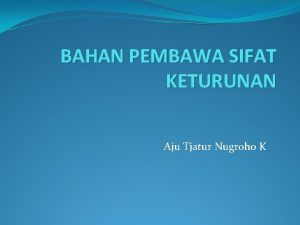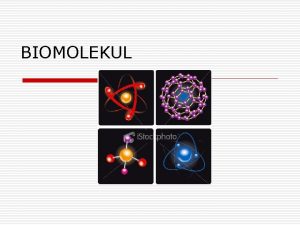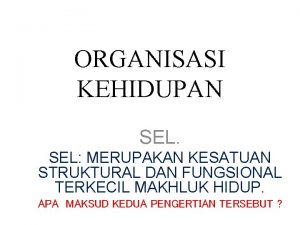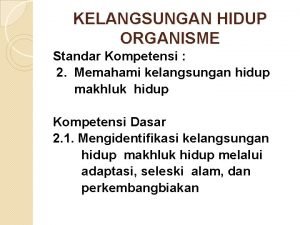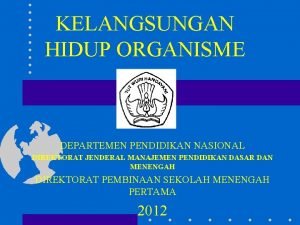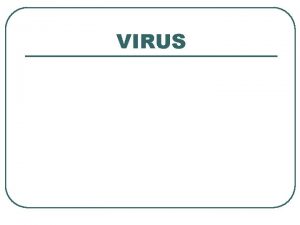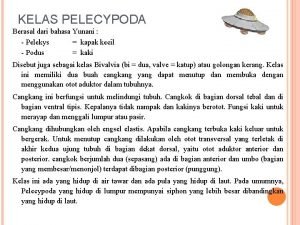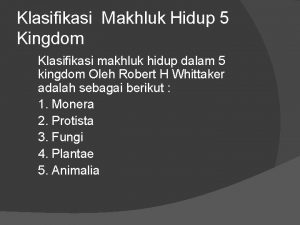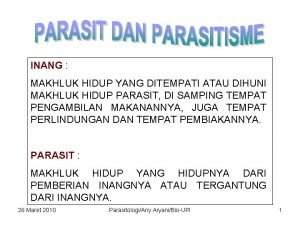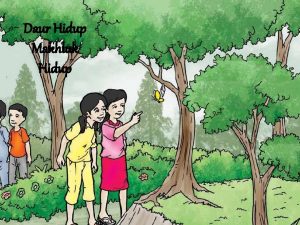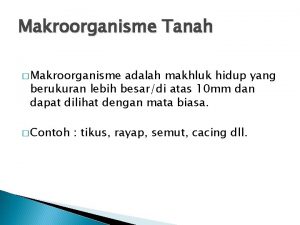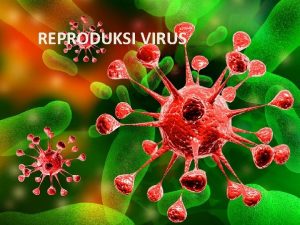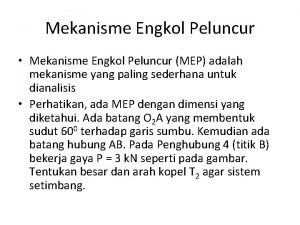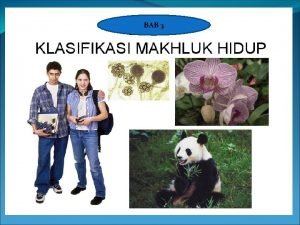Pengertian Termoregulasi Termoregulasi adalah suatu mekanisme makhluk hidup



















- Slides: 19

Pengertian Termoregulasi • Termoregulasi adalah suatu mekanisme makhluk hidup untuk mempertahankan suhu internal agar berada di dalam kisaran yang dapat ditolelir. • Proses yang terjadi pada hewan untuk mengatur suhu tubuhnya agar tetap konstan dinamis. • Mekanisme Termoregulasi terjadi dengan mengatur keseimbangan antara perolehan panas dengan pelepasan panas.

Thermoregulation • Ectotherms – Obtain body heat from their environment – Poikilotherms (changing temperature) – Most invertebrates, amphibians, reptiles, and fish – “Cold-blooded”

Most fishes, like this anemonefish, have a body temperture close to the water around them. A few fishes, like fast-swimming tuna, are able to keep their body temperture warmer than the surrounding water.

Thermoregulation • Endotherms – Generate their own body heat – Homeotherms • maintain a constant internal temperature – “Warm-blooded”

• A warm-blooded animal loses heat 25 times faster in water than in air of the same temperature. • Whales and pinnipeds (seals, sea lions, and walruses) have thick layers of fat called blubber under their skin. This helps keep heat in. • They also conserve heat by cooling blood as it flows out to thin-skinned limbs and warming it again as the cool blood comes back to the warm body core. This system, called a countercurrent heat exchange, pairs outgoing blood vessels next to incoming vessels. • This side-by-side contact lets heat travel from warm blood to cool blood. When whales and pinnipeds get too hot, they may move to colder waters or decrease their activity level. Some may also shunt blood out to the limbs where heat is lost quicker

Mechanisms of Thermoregulation • Cooling by evaporation – Lose heat by sweating – Phase change requires energy (endergonic) – Body heat is removed when water vaporizes – Evaporative heat lose occurs from the respiratory tract • Panting

Mechanisms of Thermoregulation • Warming by metabolism – Muscle contraction – Metabolic activities generate heat – Example • Shivering warms animals

Mechanisms of Thermoregulation • Various behavioral, physiological, or anatomical adaptations – Hibernation – Hair – Feathers – Blubber – Moving into shady areas, out of the direct sunlight

Heat is gained or lost in four ways • Heat exchange with the environment may occur by – conduction—the transfer of heat by direct contact, – convection—the transfer of heat by movement of air or liquid past a surface, – radiation—the emission of electromagnetic waves, or – evaporation—the loss of heat from the surface of a liquid that is losing some of its molecules as a gas.

Adaptasi terhadap suhu sangat dingin dilakukan dengan: 1. Meningkatkan konsentrasi osmotic, titik beku cairan tubuh dapat diturunkan hingga dibawah 0 o. C. Zat terlarut: gula, seperti fruktosa atau derivatnya, dan gliserol (bermanfaat untuk melindungi membran dan enzim dari denaturasi akibat suhu yang sangat dingin. contoh: lalat dari Alaska, Rhabdophaga strobiloides, yang dapat bertahan hingga suhu -60 o. C.

2. Menghambat pembentukan kristal es di dalam sel untuk mencegah kerusakan membrane. Dilakukan dengan cara menambahkan glikoprotein antibeku ke dalam cairan tubuh Glikoprotein ialah molekul polimer dari sejumlah monomer yang tersusun atas tripeptida, yang terikat pada derivat galaktosamin (alanin-treoningalaktosa derivat).

Antarctic Ice Fish • Antifreeze blood – glycoproteins • Lack RBCs and hemoglobin

Solution for Antarctic fish • Macromolecular antifreeze compounds { peptides (protein) glycopeptides (carbohydrate/protein) rich in alanine n n molecules adsorb (attach) to ice crystal surface interfere with ice crystal growth (disrupt matrix) Why is this important? ? ? ice ruptures cells; hinders osmoregulation

Temperature effects on fish • Temperature exhibits the greatest influence on fish’s lives! • Affects metabolism • Affects digestion • Signals reproductive maturation and behavior Pernyataan hokum Van’t Hoff Dari setiap peningkatan suhu sebesar 10 o. C akan meningkatkan laju konsumsi oksigen atau dalam hal ini adalah denyut jantung sebesar 2 sampai 3 kali kenaikan.

Behavioral Thermoregulation in Fishes • Although fish are ectotherms, they can alter their body temperature by moving to habitats with optimal temperature

Hot Fishes • Some fish can maintain body temperature greater than ambient - tunas, billfishes, relatives (nearly endothermic) • Use retia (similar to rete mirable) in swimming muscles to conserve heat, exchange O 2, etc. • Red muscle is medial rather than distal • Billfishes have warm brains - heat organ from muscles around eye



 Proses sintesis protein
Proses sintesis protein Kelangsungan hidup makhluk hidup
Kelangsungan hidup makhluk hidup Manusia sebagai makhluk individu dan makhluk sosial
Manusia sebagai makhluk individu dan makhluk sosial Sel penyusun
Sel penyusun Bagian terkecil makhluk hidup
Bagian terkecil makhluk hidup Tabel perbedaan spermatogenesis dan oogenesis
Tabel perbedaan spermatogenesis dan oogenesis Nata de coco bioteknologi modern
Nata de coco bioteknologi modern Mind mapping klasifikasi makhluk hidup
Mind mapping klasifikasi makhluk hidup Sel merupakan kesatuan dari
Sel merupakan kesatuan dari Membengkokkan cabang tanaman sampai menyentuh tanah
Membengkokkan cabang tanaman sampai menyentuh tanah Hubungan interaksi berupa antibiosis adalah
Hubungan interaksi berupa antibiosis adalah Penyesuaian diri makhluk hidup terhadap lingkungannya
Penyesuaian diri makhluk hidup terhadap lingkungannya Penyesuaian diri makhluk hidup terhadap lingkungan
Penyesuaian diri makhluk hidup terhadap lingkungan Pembuahan
Pembuahan Dimitri ivanowski
Dimitri ivanowski Makhluk hidup herbivora
Makhluk hidup herbivora Macam-macam panggilan hidup dalam gereja katolik
Macam-macam panggilan hidup dalam gereja katolik Bagian tubuh pelecypoda
Bagian tubuh pelecypoda Pengertian kerukunan hidup beragama adalah.... *
Pengertian kerukunan hidup beragama adalah.... * Makalah peran keluarga kristen dalam gaya hidup modern
Makalah peran keluarga kristen dalam gaya hidup modern
